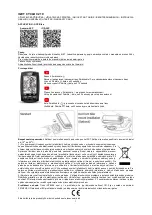
Gebrauchsanweisung / Instructions for Use - SCHMIDT
®
Flow Sensor SS 20.225
16
distance L2) is held absolutely straight and without disturbances (such as
edges, seams, bends, etc.).
L = Length of whole measuring distance
L1 = Length of run-in distance
L2 = Length of run-out distance
D = Inner diameter of measuring distance
The following table shows the required straight conduit lengths depending
on tube diameter and different disturbances.
Flow obstacle upstream of measuring distance
Minimum length of distance
Run-in (L1)
Run-out (L2)
Light bend (< 90°)
10 x D
5 x D
Reduction / expansion / 90° bend ot T-junction
15 x D
5 x D
Two 90° bends in one plane (2-dimensional)
20 x D
5 x D
Two 90° bends (3-dimensional change in direction)
35 x D
5 x D
Shut-off valve
45 x D
5 x D
This table lists the required minimum values. If the listed straight conduit
lengths cannot be achieved, measurement accuracy may be impaired
(> 1 %) or additional actions are required (like the use of flow rectifiers
13
.
Mounting
Several mounting options are available.
Using the thread of sensor enclosure
- Drill a hole with 17.5 mm, and cut a fine thread (M18 x 1).
- Screw back the lock nut on the sensor housing as far as possible.
- Remove protective cap and insert sensor probe as axially as possible
- Screw the threaded section of the sensor enclosure into the bore hole.
- Adjust immersion depth and position of enclosure, lock with nut.
Installation with a flange
SCHMIDT Technology
offers two types of flanges:
The simple mounting flange (see following grafic, left side) fixes the sen-
sor by means of a locking screw and is not pressure-tight.
The wall mounting flange (see following grafic, right side), suitable for
clean rooms, is pressure tight up to 500 mbar (sealed by an O-ring on
the contact surface) and made of stainless steel.
13
E. g. honeycombs made of plastics or ceramics; profile factor may change therefore.









































